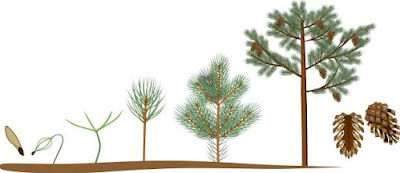This is a simple STEM activity that you can use during your science lessons
about trees, tree life cycles, habitats, and the environment. It can also be
used as an Earth Day activity. Keep reading to learn more!
Disclosure:
Affiliate links
to Amazon are included in this post.
Before you begin this science and STEM experiment, review these key vocabulary words and concepts with your students:
- life cycle
- seed
- sapling
- seedling
- pinecone
- develop / development
- mature / maturity
- germinate / germination
- evergreen / deciduous

Our Scientific Process
-by Ms. Wilson's class-
Question:
Can we grow a pine tree from some seeds?
Hypothesis:
Some people in our class believe that it's possible to plant seeds and
grow pine tree saplings. Some of the others say it's not
possible because seeds are so small and pine trees are so big!
Materials Needed:
- two or three pinecones per student
- one paper plate per student
- one bag of soil (potting mix)
- small plastic take-out containers (or something similar)
Procedure:
1. In the spring or in the autumn, go for a nature walk with your
students and collect at least two or three pinecones per student. An
ideal time to collect freshly fallen pinecones is after a windstorm!

We collected blue spruce pinecones while we were outside.
2. Squeeze, crumble, and crush the pinecones over a paper plate to
release their seeds. Some pinecones will release a lot of seeds, whereas
others will release only a few. This depends largely on how long the
pinecone was on the ground before it was picked up. The longer a
pinecone is on the ground, the more likely it is that it has already
dropped some... or all... of its seeds.

This is what it looked like when we crumbled two pinecones. Can you
see the tiny seeds?

This is a close-up view of the seeds that came out of the
pinecones.
3. Add soil to the bottom of the plastic containers. Sprinkle the seeds
from the pinecones onto the soil. Cover with a very thin layer of
additional soil. Moisten with water... do not drench! Then close the
container and set it in a warm sunny window. When the seeds start to
germinate, you can remove the lids and take care of them the way you
would take care of a houseplant.
 >
>
After several weeks, tiny pine tree saplings began to emerge!
Findings:
- We planted a lot of seeds, but less than half germinated.
- Pine tree saplings are delicate. They are hard to take care of and die easily.
- None of our seeds survived past the seedling stage.
Conclusion:
Yes, you can grow a pine tree from seeds. It is possible to plant the
seeds from a pinecone and have pine tree seedlings germinate from
them.
Extending Our Knowledge:
- We did some research and learned that pine trees have a lot of seeds in their pinecones to ensure their survival. Even though one pine tree can drop dozens of pinecones each year, very few of the seeds actually germinate and even fewer will survive.
- We also learned that crossbills, woodpeckers, squirrels, and people like to eat pinecones and their seeds. Animals like squirrels, rabbits, voles, and porcupines like to eat seedlings. This means even fewer... if any... of the saplings will make it to maturity.
- If our pine tree seedlings had survived, it would have taken 25 to 30 years for them to reach maturity.
- After doing this STEM experiment, we learned why it's important to plant three seeds every time you chop down one tree... not every seed you plant will develop into a mature tree!

This is a pine tree sapling at a nursery. Will it beat the odds and
reach its maturity?

Did you enjoy this blog post about growing pine trees? If so, check
out these blog posts from more plant and gardening activities:
- STEM + Craft: How to Make Seed Paper Hearts
- STEM Activity: Pumpkin Life Cycle STEM Activity ("Pumpkin Jack")
- STEM Activity: How to Grow Radishes from Scraps
- STEM Activity: Learning About Dandelion Life Cycles
- STEM Activity: How to Grow Celery from Scraps
- STEM Activity: Dirty Socks STEM Experiment: How Do Seeds Travel?
- STEM Activity: Do Squirrels Eat Pumpkins?

